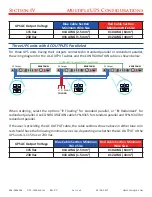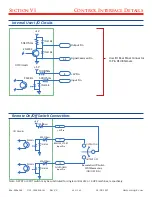
006-0006205
UPS-1500 Series
Rev ZC
43 of 60
05/28/2019
Section V
Battery Pack
Battery Technology
The battery packs for the UPS-1500 Series contain Lithium Polymer rechargeable batteries. For a
given amount of energy storage they are much smaller and lighter than a lead-acid battery. They
are capable of very high discharge rates and fast recharging, and can do so over many cycles and
over a long life. As such they are very suitable for a UPS application. Lithium Polymer batteries
are used in many military applications.
Electronic Circuitry within the Battery Pack
The SynQor battery pack has electronic circuitry within it that:
• controls the charging (including the equalization charging) of the battery
• separates the battery cells into multiple segments
• provides protection of the battery
• runs diagnostics on the battery
• controls the battery pack’s front panel LED indicators
The purpose of separating the battery cells into multiple segments is to allow the battery pack to
remain useful even if one of its battery cells fails. In a normal battery configuration, the failure of
a single cell would disable the entire battery. The SynQor battery packs are designed with their
battery cells arranged in segments that can be disconnected from the other segments by the
internal electronic circuitry. Therefore, if a battery cell fails in one segment, the battery pack can
still operate with the remaining segments (at a reduced battery run-time) until the battery pack
can be serviced.
The Standard Battery Pack (that fits in the UPS-1500S units) has 3 segments, so a failure of a
battery cell would still allow at least 2/3
rds
of the battery pack’s run-time to be available. The
Extended Battery Pack (that fits in the UPS-1500E units) has 7 segments, so a failure of a battery
cell would still allow at least 6/7
ths
of the battery pack’s run-time to be available.
The protection features provided by the electronic circuitry include:
• Maximum Current Limit when the battery is being charged/discharged
• Charging/Discharging Limit to avoid over-charging/discharging of the battery
• Charging/Discharging Disable if the battery is too hot or too cold
• Disconnect of the battery from the battery pack’s terminals when the pack is not
inserted into the UPS
















































